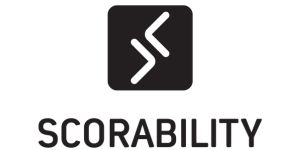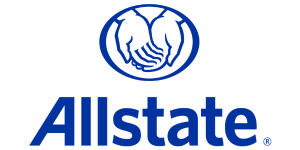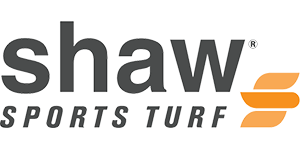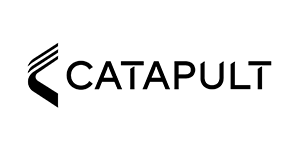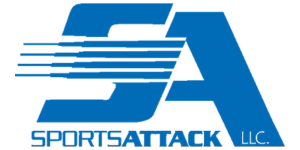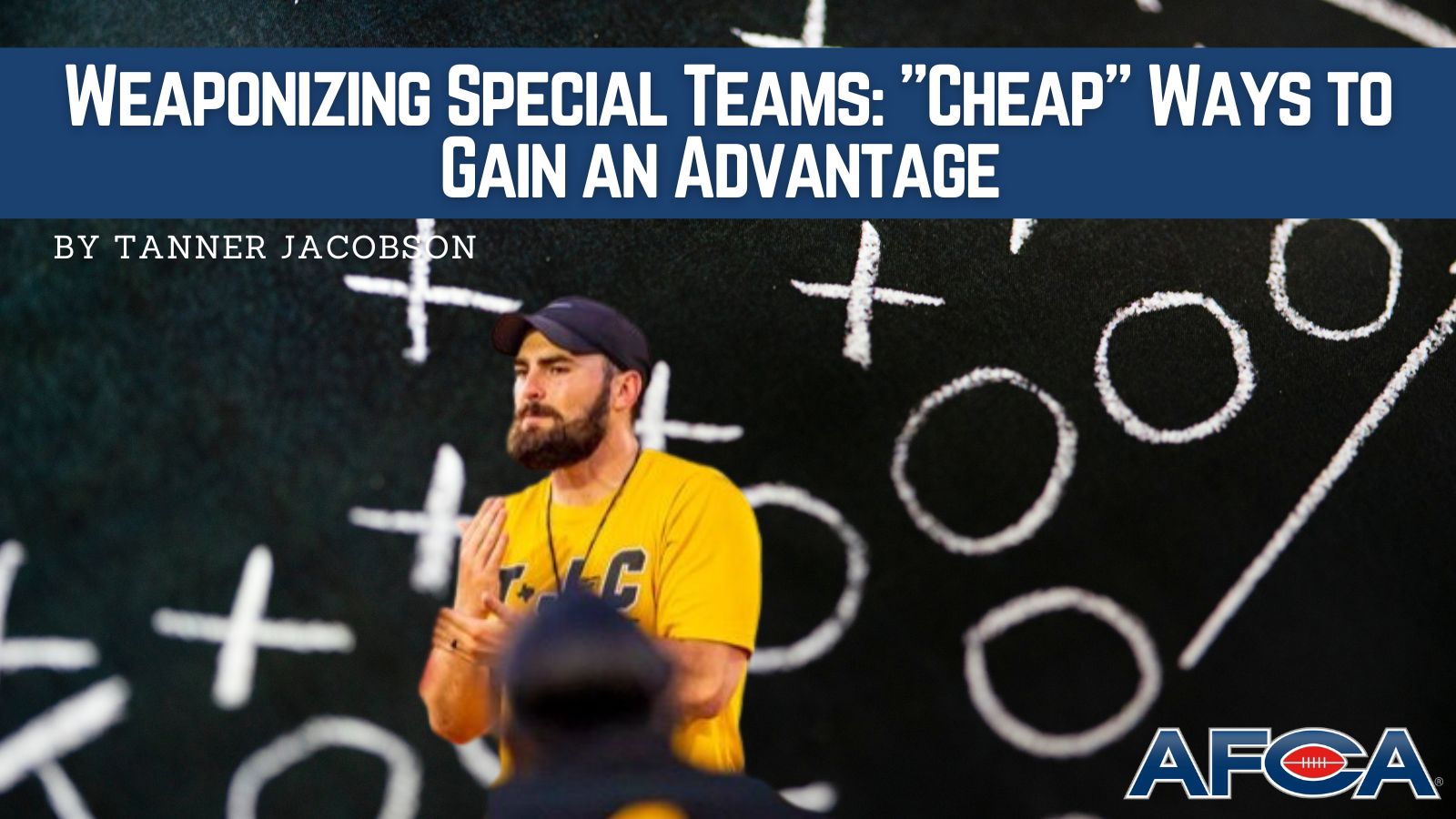
Weaponizing Special Teams: “Cheap” Ways to Gain an Advantage
May 16, 2023
In a study done by Daniel Da Prato, Special Teams Coordinator for Texas State, he found that 52% of all the yards in a game came from special teams. If more than half the yards in a given game come from Special Teams then we better have a philosophy. I am a firm believer in weaponizing Special Teams, meaning, we will have ways to put opposing players in conflict and make game-changing plays. Two ways I want to explain, two ways of weaponizing special teams “Cheap of us, Expensive for Them” and “Keeping Bullets in the Chamber”.
It has become a common phrase in coaching to hear the term, “It’s a cheap way to do this, or It’s a cheap way to do that.” This means, there are concepts that we can teach as coaches that are easy for our players to understand, but those same things that are easy techniques or adjustments are very difficult on our opposing teams. Just like defenses use creepers or simulated pressures to make it look like there is a blitz coming but still maintain our 7 players in coverage. I would like to explain how I use this concept on kick-off. Special Teams is one of the most rapidly evolving aspects of football. With constant rule changes and changes of team makeup (More DBs and WRs than TEs and LBs), special team coordinators have been forced to be creative.
I first came across the idea of making things difficult on Kick-off as a young coach at BYU. While game prepping for the University of Washington, I noticed that every kickoff, Washington used a different way of “waterfalling” their approach. Being responsible for the kickoff return team; this caused me some stress. My preparation time became “expensive” as I needed to use more time trying to find patterns and break the code of when and why their start changed. Once I did figure out a pattern, I then needed to figure out how to clearly and efficiently communicate the scheme to our KOR team to make it easier for them. Not only was it time-consuming for me as a coach, it was time-consuming during practice. We had to take more time explaining who each player would be blocking and then with that, we had less time to actually practice the return in the live portion of practice. Even with all of that, it was still a toss-up if our opponent was going to use the anticipated kickoff approach. During this time I realized that when I became a special teams coordinator, I would use that concept as part of my kick-off team philosophy.
Another cheap aspect of the kick-off team is the ever-present threat of a surprise onside kick. Again, during my time at BYU, a valuable part of my coaching philosophy was formed, “Always keep some bullets in the chamber.” In 2020, BYU was having a remarkable run. Through all of the chaos of COVID cancellations and Zach Wilson’s madness, the Cougars were on a roll. At 4-0 BYU rolled into Houston for their first real test of the season. With just over a minute left in the 3rd quarter, down 14-26, the BYU offense scored to make it 21-26. Needing to capitalize on some momentum, BYU elected to use a surprise onside kick which was successful. BYU went on to win 43-26.
That surprise onside kick was something that was practiced every week during our kickoff period of the season not knowing the time or situation that it would need to be used. I took these concepts with me as a special teams coordinator to Snow College where we lost 3 games in a span of two years.
Though both concepts of “Cheap for Us, Expensive for them” and “Keep some Bullets in the Chamber” are applicable to essentially all aspects of football, I have chosen to highlight how I use them for our kick-off units.

Above is your basic diagram for a “Deep Left” kickoff call. You have your lanes and Landmarks spanning the numbers to the sideline. In the boxes, you have your responsibilities for the kickoff coverage teams.
- He is a contained player. The #1 will force any and everything back inside.
- This is the Spill player, This player’s responsibility is crucial to the design of the kickoff. He is responsible to “spill” or cut across the returner’s face in an effort to make a tackle but is unsuccessful in his tackling attempt, he should stop the returner’s momentum and force him laterally. The 1 and the 3 players should be anticipating this spill.
- 3/4/5 You will notice these are the pick players. Any sort of pick will be executed by one of these players in an effort to avoid double teams. Most KOR teams will choose to double-team one of these players. Lane adjustments by these players are very common.
- See 3
- See 3
- 6/7 We now have our waterfall side. 6 and 7 must identify the return direction, typically by reading the upbacks, and avoid the return side.
- See 6
- The 8 is what many teams refer to as the safety but I prefer the term linebacker. As you give returners more space they become more electric so my philosophy is to have the 8 play more like a linebacker instead of a safety in an effort to box the returner in before he has more space.
- Contain Player, nothing should get outside of him, 21 men inside.
- Another Linebacker, a way to think of this Kickoff concept is to think 2-7 and 9 are the Defensive linemen, while 1, 8, and 10 are Linebackers, leaving the Kicker as the safety.
- Kicker, ball placement needs to be left of the hash inbounds.
I realize this is nothing earth-shattering but it shouldn’t be. It is our job as coaches to keep things as simple as they can be to allow our players to play fast and not think. Always avoid Paralysis by analysis. Now time to get into the tweaks to make it expensive.
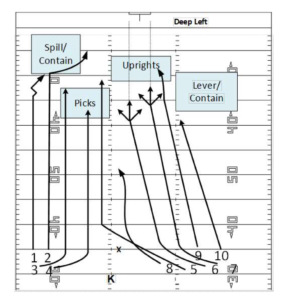
You will notice that all of the players have the exact same responsibilities but now have just changed their alignments slightly. This may change everything for a KOR team but changes very little for our kick-off team. Cheap for us, expensive for them. The 8 can constantly change his alignment without jeopardizing his assignment. This changing of alignments messes up the count for a KOR team. Instead of a clear picture, we are now making KOR teams work extra hard just to make sure they are blocking the right person. There have been some weeks where I knew that return teams wanted to double our 5 above but 8 was aligned there. This led them to have terrible angles to block the 5 and 6. Opposing teams were forced to focus heavily on their man in order to decipher which jersey number to block. But with the stacking position of our players, this was very difficult to see. Along with constantly changing where the 8 lined up on the right, we also changed which two players were in front or behind the waterfall on the left.
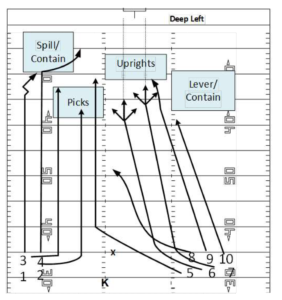
Imagine that you worked all week and that your blocking assignment was the 3 in the above diagram. You would anticipate that he had a waterfall approach but then suddenly the 1 and 2 waterfall.
Now we move to keep a bullet in the chamber. During game preparation each week we look for holes in schemes all over. One of these elements I look for is the front line. What is their alignment? Do they leave early? Do we anticipate a dribble kick being open? What about a chip kick? These are questions that I always ask myself when prepping for games. Then, once a game begins, you confirm that those holes you were looking for are available on game day. You never know in the flow of the season or in the flow of a game if you will need a spark much like we did at BYU in 2020.
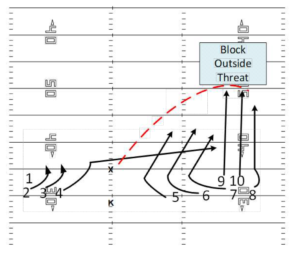
This is our alignment for our surprise onside kick from Spring 2021 and Snow College which was executed successfully against Lackawanna. With all of our different alignments, it can be difficult for players to remember some of the little things especially if alignment issues create difficult blocking angles. Coaching Points for Chip 8 are:
- Be Onside, if in a stacked position, do not even move
- Use a normal approach but be onsides, (Officials are taught to officiate a vertical plane and officiate specialty kicks more strictly.)
- See 2
- Normal Approach fade to the Kick side to become a safety
- See 2
- See 2
- See 2
- Be Onside, get a running start, attack the ball, and go down after securing possession
- Be Onside, attack the furthest outside threat
- See Nine
- Kicker: Drop it in the bucket between the 5&0
This particular formation with our players inside that number was an effort to create space for our kicker to drop our surprise kick into more space. With all our players inside, it was difficult for opposing front line players to block us. With their adjustments, the space from the last line defender to the sideline got bigger and bigger.
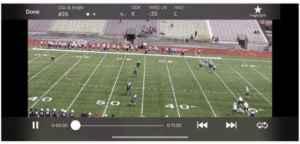
These concepts can be used in a variety of different ways across all three phases of the game. I truly believe that Special Teams should be a weaponized portion of the game. We should strive to put opposing players and positions in conflict. Keeping things simple for our team and complex for the opposing teams is how you can gain advantages. With the constant evolution of the rules of Football, we must be creative as Special Teams Coordinators. These concepts are two that can be beneficial to anyone looking to gain an advantage on kickoff coverage.
For more information about the AFCA, visit www.AFCA.com. For more interesting articles, check out The Insider and subscribe to our weekly email.
If you are interested in more in-depth articles and videos, please become an AFCA member. You can find out more information about membership and specific member benefits on the AFCA Membership Overview page. If you are ready to join, please fill out the AFCA Membership Application.
« « Previous PostNext Post » »
In a study done by Daniel Da Prato, Special Teams Coordinator for Texas State, he found that 52% of all the yards in a game came from special teams. If more than half the yards in a given game come from Special Teams then we better have a philosophy. I am a firm believer in weaponizing Special Teams, meaning, we will have ways to put opposing players in conflict and make game-changing plays. Two ways I want to explain, two ways of weaponizing special teams “Cheap of us, Expensive for Them” and “Keeping Bullets in the Chamber”.
It has become a common phrase in coaching to hear the term, “It’s a cheap way to do this, or It’s a cheap way to do that.” This means, there are concepts that we can teach as coaches that are easy for our players to understand, but those same things that are easy techniques or adjustments are very difficult on our opposing teams. Just like defenses use creepers or simulated pressures to make it look like there is a blitz coming but still maintain our 7 players in coverage. I would like to explain how I use this concept on kick-off. Special Teams is one of the most rapidly evolving aspects of football. With constant rule changes and changes of team makeup (More DBs and WRs than TEs and LBs), special team coordinators have been forced to be creative.
I first came across the idea of making things difficult on Kick-off as a young coach at BYU. While game prepping for the University of Washington, I noticed that every kickoff, Washington used a different way of “waterfalling” their approach. Being responsible for the kickoff return team; this caused me some stress. My preparation time became “expensive” as I needed to use more time trying to find patterns and break the code of when and why their start changed. Once I did figure out a pattern, I then needed to figure out how to clearly and efficiently communicate the scheme to our KOR team to make it easier for them. Not only was it time-consuming for me as a coach, it was time-consuming during practice. We had to take more time explaining who each player would be blocking and then with that, we had less time to actually practice the return in the live portion of practice. Even with all of that, it was still a toss-up if our opponent was going to use the anticipated kickoff approach. During this time I realized that when I became a special teams coordinator, I would use that concept as part of my kick-off team philosophy.
Another cheap aspect of the kick-off team is the ever-present threat of a surprise onside kick. Again, during my time at BYU, a valuable part of my coaching philosophy was formed, “Always keep some bullets in the chamber.” In 2020, BYU was having a remarkable run. Through all of the chaos of COVID cancellations and Zach Wilson’s madness, the Cougars were on a roll. At 4-0 BYU rolled into Houston for their first real test of the season. With just over a minute left in the 3rd quarter, down 14-26, the BYU offense scored to make it 21-26. Needing to capitalize on some momentum, BYU elected to use a surprise onside kick which was successful. BYU went on to win 43-26.
That surprise onside kick was something that was practiced every week during our kickoff period of the season not knowing the time or situation that it would need to be used. I took these concepts with me as a special teams coordinator to Snow College where we lost 3 games in a span of two years.
Though both concepts of “Cheap for Us, Expensive for them” and “Keep some Bullets in the Chamber” are applicable to essentially all aspects of football, I have chosen to highlight how I use them for our kick-off units.

Above is your basic diagram for a “Deep Left” kickoff call. You have your lanes and Landmarks spanning the numbers to the sideline. In the boxes, you have your responsibilities for the kickoff coverage teams.
- He is a contained player. The #1 will force any and everything back inside.
- This is the Spill player, This player’s responsibility is crucial to the design of the kickoff. He is responsible to “spill” or cut across the returner’s face in an effort to make a tackle but is unsuccessful in his tackling attempt, he should stop the returner’s momentum and force him laterally. The 1 and the 3 players should be anticipating this spill.
- 3/4/5 You will notice these are the pick players. Any sort of pick will be executed by one of these players in an effort to avoid double teams. Most KOR teams will choose to double-team one of these players. Lane adjustments by these players are very common.
- See 3
- See 3
- 6/7 We now have our waterfall side. 6 and 7 must identify the return direction, typically by reading the upbacks, and avoid the return side.
- See 6
- The 8 is what many teams refer to as the safety but I prefer the term linebacker. As you give returners more space they become more electric so my philosophy is to have the 8 play more like a linebacker instead of a safety in an effort to box the returner in before he has more space.
- Contain Player, nothing should get outside of him, 21 men inside.
- Another Linebacker, a way to think of this Kickoff concept is to think 2-7 and 9 are the Defensive linemen, while 1, 8, and 10 are Linebackers, leaving the Kicker as the safety.
- Kicker, ball placement needs to be left of the hash inbounds.
I realize this is nothing earth-shattering but it shouldn’t be. It is our job as coaches to keep things as simple as they can be to allow our players to play fast and not think. Always avoid Paralysis by analysis. Now time to get into the tweaks to make it expensive.

You will notice that all of the players have the exact same responsibilities but now have just changed their alignments slightly. This may change everything for a KOR team but changes very little for our kick-off team. Cheap for us, expensive for them. The 8 can constantly change his alignment without jeopardizing his assignment. This changing of alignments messes up the count for a KOR team. Instead of a clear picture, we are now making KOR teams work extra hard just to make sure they are blocking the right person. There have been some weeks where I knew that return teams wanted to double our 5 above but 8 was aligned there. This led them to have terrible angles to block the 5 and 6. Opposing teams were forced to focus heavily on their man in order to decipher which jersey number to block. But with the stacking position of our players, this was very difficult to see. Along with constantly changing where the 8 lined up on the right, we also changed which two players were in front or behind the waterfall on the left.

Imagine that you worked all week and that your blocking assignment was the 3 in the above diagram. You would anticipate that he had a waterfall approach but then suddenly the 1 and 2 waterfall.
Now we move to keep a bullet in the chamber. During game preparation each week we look for holes in schemes all over. One of these elements I look for is the front line. What is their alignment? Do they leave early? Do we anticipate a dribble kick being open? What about a chip kick? These are questions that I always ask myself when prepping for games. Then, once a game begins, you confirm that those holes you were looking for are available on game day. You never know in the flow of the season or in the flow of a game if you will need a spark much like we did at BYU in 2020.

This is our alignment for our surprise onside kick from Spring 2021 and Snow College which was executed successfully against Lackawanna. With all of our different alignments, it can be difficult for players to remember some of the little things especially if alignment issues create difficult blocking angles. Coaching Points for Chip 8 are:
- Be Onside, if in a stacked position, do not even move
- Use a normal approach but be onsides, (Officials are taught to officiate a vertical plane and officiate specialty kicks more strictly.)
- See 2
- Normal Approach fade to the Kick side to become a safety
- See 2
- See 2
- See 2
- Be Onside, get a running start, attack the ball, and go down after securing possession
- Be Onside, attack the furthest outside threat
- See Nine
- Kicker: Drop it in the bucket between the 5&0
This particular formation with our players inside that number was an effort to create space for our kicker to drop our surprise kick into more space. With all our players inside, it was difficult for opposing front line players to block us. With their adjustments, the space from the last line defender to the sideline got bigger and bigger.

These concepts can be used in a variety of different ways across all three phases of the game. I truly believe that Special Teams should be a weaponized portion of the game. We should strive to put opposing players and positions in conflict. Keeping things simple for our team and complex for the opposing teams is how you can gain advantages. With the constant evolution of the rules of Football, we must be creative as Special Teams Coordinators. These concepts are two that can be beneficial to anyone looking to gain an advantage on kickoff coverage.
For more information about the AFCA, visit www.AFCA.com. For more interesting articles, check out The Insider and subscribe to our weekly email.
If you are interested in more in-depth articles and videos, please become an AFCA member. You can find out more information about membership and specific member benefits on the AFCA Membership Overview page. If you are ready to join, please fill out the AFCA Membership Application.


